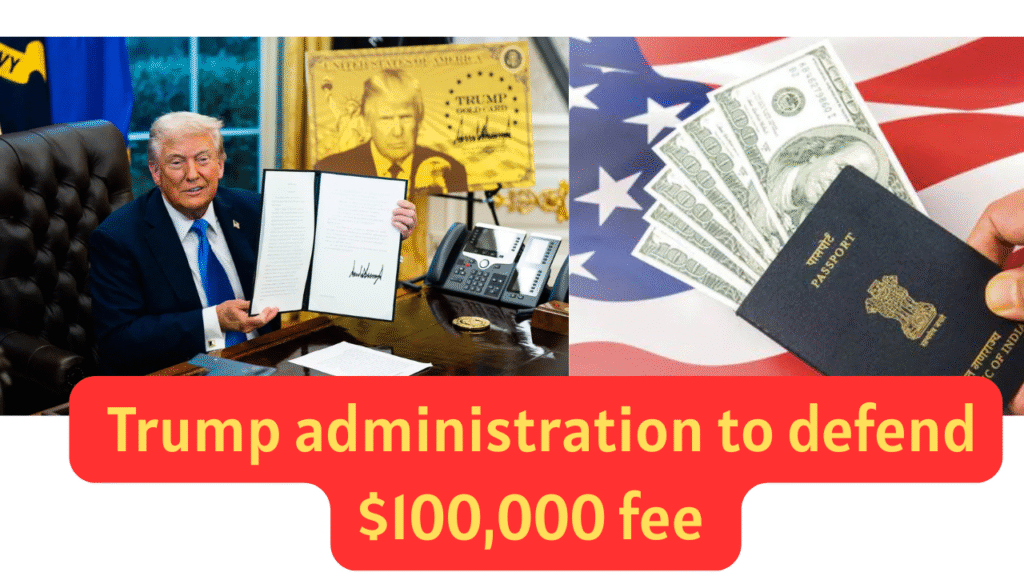Introduction
The employment-based visa program known as the H‑1B visa in the United States stands at the centre of a heated policy battle. On one side, the administration of Donald Trump (the “Trump administration”) has introduced a dramatic surcharge of US $100,000 on new H-1B visa petitions, claiming the system has been “spammed with fraud” and has driven down American wages. On the other side, business groups, tech companies, trade associations and others are mounting legal challenges, arguing that the fee is unlawful, will stifle innovation and harm U.S. competitiveness. This article explores the background of the H-1B program, the reasons given by the administration for the fee hike, the opposition and legal challenges, the implications for employers and foreign workers (especially from India), and what the future may hold.
What is the H-1B visa system?
The H-1B visa is a non-immigrant visa category in the U.S. for “specialty occupations”, allowing U.S. employers to hire foreign workers in roles that typically require at least a bachelor’s degree or its equivalent in a relevant field (for example, engineering, information technology, medicine, architecture).
Historically, the program has an annual cap of 65,000 new H-1B visas plus an additional 20,000 for persons with U.S. advanced degrees, making approximately 85,000 new visas available each year (excluding cap-exempt employers such as universities).
Employers must file a Labor Condition Application (LCA) attesting that the foreign worker will be paid at least the prevailing wage, that the employment will not adversely affect the conditions of U.S. workers, and other attestations. The Department of Labor & U.S. Citizenship and Immigration Services (USCIS) oversee the system.
Over time, the H-1B program has become critically important for U.S. companies—especially in the tech, engineering and healthcare sectors—to access global talent. Yet it has also been subject to persistent criticism about wage suppression, outsourcing, worker displacement, and misuse of the program.
What’s new: the $100,000 fee and the claim of fraud
The fee hike

In September 2025, President Donald Trump signed a proclamation titled “Restriction on Entry of Certain Non-immigrant Workers” (or similar wording) that introduced a US $100,000 annual fee for new H-1B visas (initial petitions) for employers. mint+1
According to reports, the fee applies to new petitioners, not to renewals or extensions for existing H-1B visa holders. The Economic Times+1
The administration argues that the fee is “lawful, necessary” and part of a broader reform to protect American workers and curb misuse of the H-1B programme. Hindustan Times+1
Claim of fraud
One of the central arguments made by the White House is that the H-1B system has been “spammed with fraud”, and that this exploitation has driven down wages for American workers. At a White House press briefing, Press Secretary Karoline Leavitt stated: “For far too long, the H-1B visa system has been spammed with fraud, and that’s driven down American wages.” www.ndtv.com+1
The framing is that certain employers abuse the H-1B programme—by using it to bring in foreign workers at lower wages, displacing U.S. workers, or misrepresenting their actual use of the visas. The new fee, the administration says, will discourage frivolous or abusive applications and preserve the integrity of the system. mint+1
Opposition and legal challenges
Key opponents
The fee hike has triggered lawsuits and pushback from major business and industry groups. For example, the U.S. Chamber of Commerce has filed a lawsuit arguing that the $100,000 fee is unlawful because it overrides provisions of the Immigration and Nationality Act (INA), which limits visa fees to reflect actual processing costs. Business Today+1
In addition to the business community, a coalition of unions, religious groups, employers and educational organisations have filed legal challenges—arguing the policy is arbitrary and capricious, may harm start-ups and small and mid-sized enterprises, and undermine American competitiveness. The Economic Times+1
Legal arguments and points of contention
- Statutory authority: Opponents argue that the executive branch lacks the authority to impose a fee of this magnitude outside of legislation passed by Congress. For instance, the Chamber lawsuit states that the President exceeded his authority under the INA. Reuters+1
- Cost-basis of fees: The INA requires that visa fees be tied to government processing costs, not used as a policy tool to discourage use of a program. Critics say the $100,000 fee far exceeds any processing cost and is being used as a deterrent rather than for cost recovery. Hindustan Times+1
- Effect on employers & innovation: Many tech firms, start-ups and service providers warn that the fee makes H-1B sponsorship cost-prohibitive, especially for smaller enterprises, which could hamper growth, innovation and U.S. competitiveness. www.ndtv.com
- Impact on foreign nationals: Since a large share of H-1B recipients come from certain countries (notably India), the fee poses major implications for global talent flows, U.S. tech dependency, and bilateral relations. The Economic Times+1
Administration’s defence
In defending the fee, the Trump administration reiterates that the H-1B programme has been misused and that reforms are required. Leavitt said the actions “are lawful… necessary… we’ll continue to fight this battle in court.” Hindustan Times+1
A White House statement argued the programme has encouraged companies to hire cheaper foreign labour instead of investing in American workers, thereby harming wages and job prospects. The surcharged fee is presented as a mechanism to raise the cost of replacing American workers with foreign ones. Business Today
Why is this a big deal? Implications and context
For U.S. employers and industries
Many U.S. companies rely heavily on H-1B visas, especially in sectors such as technology, engineering, healthcare and research. A massive fee increase will raise their labour cost significantly (by $100,000 per petition), potentially altering hiring strategies. Some firms may reduce their reliance on the H-1B programme, offshore roles instead, or delay hiring foreign talent. The business community warns this may slow growth, hurt competitiveness, and discourage innovation. www.ndtv.com+1

Start-ups and midsize firms are seen as particularly vulnerable: they may lack the budget to absorb such surcharges, and hence could forego hiring foreign talent, even if they need highly skilled workers. The Chamber of Commerce highlighted this risk. Hindustan Times
For foreign skilled workers
For prospective H-1B applicants—particularly from India (which accounts for roughly 71 % of approved H-1Bs in recent years) The Economic Times+1—this fee means their sponsorship by the employer becomes much more expensive, possibly reducing their job prospects. While the administration clarified the fee applies to new petitions, not existing visa holders or extensions, the chilling effect is significant. New York Post
Moreover, the fee hike signals a broader immigration climate shift, which may deter foreign talent, affect global mobility, and influence how U.S. companies think about hiring and location strategy. The Indian government, for instance, has criticized the U.S. move, saying it reflects a fear of Indian talent. The Guardian
For U.S. workers
From the administration’s viewpoint, the reform is pro-worker: by raising the cost for hiring foreign skilled labour, the hope is that employers will prioritise training and hiring Americans, thereby improving wages and employment opportunities for U.S. nationals. This logic reflects a more protectionist and labour-first approach to skilled immigration. mint+1

On policy and legal precedent
This move marks one of the most radical interventions into the H-1B programme in decades. By imposing a policy tool in the form of a severe fee increase, the administration is signalling a shift from facilitating skilled immigration to making it more expensive and restrictive. How courts respond will set precedent on executive authority in immigration and visa policy, fee structures, and the balance between open skilled immigration and protection of domestic workers.
What are the key questions and criticisms?
Is there really widespread fraud?
The administration argues the H-1B system has been “spammed with fraud”. While misuse of the H-1B programme is documented (for example, outsourcing firms using it to staff lower-wage positions), the term “spammed with fraud” is sweeping. Critics ask for empirical evidence to justify a fee of this scale, and whether reform might better focus on enforcement, wage requirements and improved oversight rather than a blunt fee.
Will raising the fee reduce foreign hiring or just shift costs?
One criticism is that the fee might simply increase overall costs for employers, which could be passed on in other ways (e.g., lower hiring levels, fewer benefits, or relocation of jobs outside the U.S.). The authorities’ assumption that employers will revert to hiring American workers may not hold if the underlying reason for foreign hiring is genuine talent shortage.

Does it undermine U.S. innovation and competitiveness?
The tech industry argues that America’s competitive edge has been built on attracting global talent. If the U.S. imposes prohibitive fees, foreign professionals may choose other countries (Canada, Australia, EU) with more favourable terms. Some worry about “brain drain” in reverse. www.ndtv.com
Legal and Constitutional concerns
The lawsuits argue that the President cannot unilaterally impose massive fees without Congressional approval, particularly when the visa programme is defined by statute (the INA). Also, the idea of using visa fees as a discouragement tool (rather than cost recovery) may violate the statute’s purpose. The outcome of litigation will be watched closely.
Impact on small and mid-sized firms
While large firms might absorb the cost, smaller firms may not. There is concern that the fee may tilt the ecosystem in favour of big companies, undermining entrepreneurship and competition.
What does this mean for India and other source countries?
As noted, Indian nationals account for roughly 71 % of recent H-1B approvals. The Economic Times The fee hike thus has outsized implications for Indian professionals and Indian IT-services companies sponsoring workers in the U.S. On one hand, it may reduce their access to U.S. employment; on the other, it may push these firms to offshore more work rather than send workers to the U.S.
India’s government has publicly reacted, with statements such as “Afraid of our talent” to describe the U.S. policy. The Guardian The ripple effect may include slower hiring of Indian workers, changes in how Indian IT companies approach U.S. business, and possible strain in bilateral labour/immigration relations.
Other source countries could similarly be affected, though those with lower representation may feel the impact less acutely.
Possible scenarios and what to watch
Scenario 1: Fee implementation and companies pay
If the fee stands, many companies (especially large ones) will continue to sponsor H-1Bs, absorbing the cost or passing it on. Smaller companies may pull back, reducing new hires of foreign workers. Over time, this may reduce the number of new H-1B visas and shift hiring strategies.
Scenario 2: Legal challenge succeeds
If the courts find the fee unlawful (for example, because it exceeds the authority of the President, or violates statute), the fee could be struck down, rolled back or modified. That outcome would reaffirm Congress’s primacy in immigration policy and limit executive fee-setting power.
Scenario 3: Revision or compromise
The administration might negotiate or adjust the policy—reduce the fee, introduce exemptions, target only certain industries or employers, or combine fee reform with stricter wage/hiring requirements. This compromise path might ease the burden while addressing the fraud/abuse concern.
What to watch in the short term
- Outcomes of the lawsuits filed by the U.S. Chamber of Commerce and others. AP News+1
- Implementation guidelines: Which petitions will be subject to the fee, how exemptions will work, how the fee will be collected.
- Reactions from major U.S. employers and how they alter hiring strategies.
- Responses from Indian and other governments and how labour-mobility flows change.
- Possible legislative action in Congress to reform the H-1B programme or override the fee.
Conclusion
The new US$100,000 fee on new H-1B visa petitions marks one of the most significant changes to the U.S. skilled-immigration system in recent memory. Framed by the Trump administration as a necessary step to combat fraud and protect American workers, the policy is equally being viewed by critics as a blunt instrument that risks undermining U.S. competitiveness, harming foreign-worker flows (especially from India), and burdening employers. The outcome of the legal challenges and how stakeholders adapt will shape the next chapter of U.S. high-skilled immigration policy.
Whether the fee becomes a model for tightening immigration access, or whether it is struck down or revised, the consequences will ripple across global talent markets, the U.S. labour force, and the future of the H-1B programme itself.


